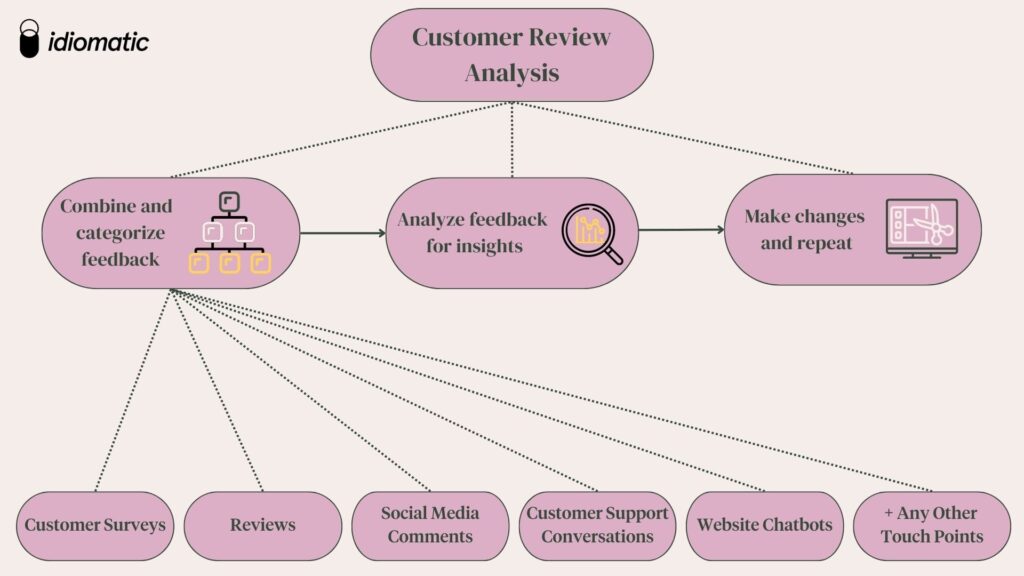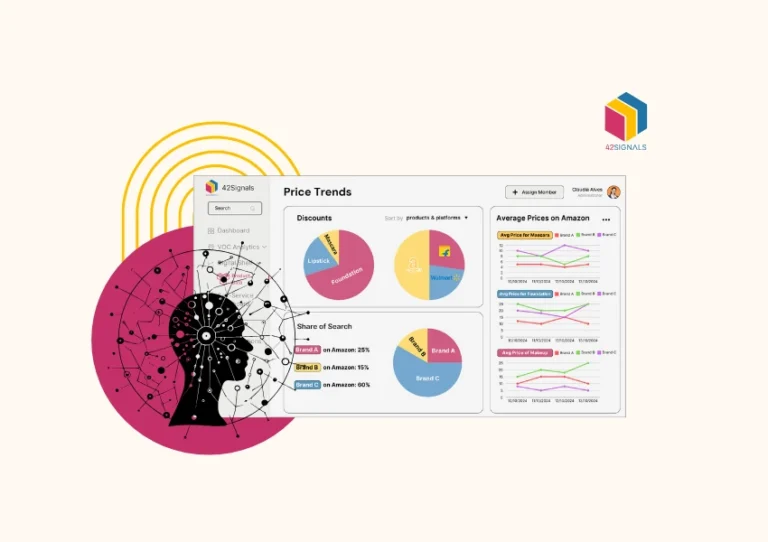What is Customer Review Analysis
Customer Review Analysis is the process of analyzing and interpreting customer reviews and feedback about products or services offered by a business. It involves using techniques such as sentiment analysis and natural language processing to understand customer feedback and identify patterns and trends in customer behavior.
By analyzing customer reviews, ecommerce businesses can gain insights into customer needs, preferences, and pain points. They can use this information to improve their products or services, identify areas for improvement, and enhance customer satisfaction.

Image Source: Idiomatic
Customer review analysis can also help ecommerce businesses to identify and respond to negative feedback promptly, improving their reputation and customer retention. Additionally, it can help businesses identify potential product issues and proactively address them before they become widespread and maintain a positive reputation in the market.
Why are Customer Reviews Important for eCommerce Businesses
Customer reviews help build social proof and trust among potential customers. When customers leave positive reviews, it shows that others have had a good experience with the product or service, making it more likely for new customers to make a purchase. On the other hand, negative reviews can provide valuable feedback for the business to improve its offerings and customer service.
Secondly, reviews can help improve a business’s search engine rankings. Reviews with relevant keywords can improve a business’s visibility in search engine results pages, making it easier for customers to find and consider the business.
Lastly, customer review analysis can help businesses identify and address any issues with their products or services, leading to improved customer satisfaction and loyalty.
Why is it Important for an eCommerce Business to Analyze Customer Reviews

Image Source: Monkey Learn
Customer reviews are far more than just star ratings; they represent a continuous, unfiltered stream of Voice of the Customer (VoC) data. Systematically analyzing this data is not just “nice-to-have,” it’s a critical strategic imperative for eCommerce success. Here’s why, in greater detail:
Understanding customer needs and preferences with customer review analysis
Customer reviews can provide insights into what customers like and dislike about products or services, their pain points, and what they expect from a business. Analyzing this can help ecommerce businesses identify areas for improvement and develop products or services that better meet customer needs and preferences.
- Beyond Likes/Dislikes: Reviews uncover the specific reasons behind sentiment. What exactly makes a product “durable” or “flimsy”? What features are unexpectedly loved or frustratingly missing?
- Identifying Unmet Needs: Customers often explicitly state what they wish the product did or how it could be improved (“I wish it had…”, “If only it could…”). This is gold dust for innovation and product development.
- Segmenting Feedback: Analysis can reveal if needs differ significantly by customer segment (e.g., beginners vs. professionals, different use cases).
- Validating Assumptions: Product managers and marketers can test their hypotheses about target audiences and value propositions against real user feedback.
Improving customer satisfaction
Analyzing customer reviews helps ecommerce businesses to identify common complaints and issues that customers face. By addressing these concerns and making necessary improvements, businesses can improve customer satisfaction, retention, and loyalty.
- Proactive Problem Solving: Identifying recurring complaints (e.g., sizing issues, slow shipping, confusing assembly) allows businesses to fix systemic problems before they affect more customers.
- Personalized Service & Recovery: Analysis flags individual negative reviews for timely, empathetic, and effective resolution, turning detractors into potential promoters.
- Building Trust & Transparency: Publicly responding thoughtfully to reviews (both positive and negative) shows customers you listen and care, fostering trust.
- Increasing Retention & CLV: Satisfied customers who feel heard are far more likely to repurchase and become loyal, directly boosting Customer Lifetime Value (CLV). Addressing issues reduces churn.
Identifying areas for improvement
Customer review analysis can reveal areas where a business is falling short, such as poor customer service or product quality issues. Analyzing this feedback can help businesses identify the root cause of these issues and take necessary corrective actions.
- Root Cause Analysis: It’s not enough to know “customer service is bad.” Reviews reveal why – long wait times, unhelpful agents, difficult return processes – enabling targeted fixes.
- Product Quality Control: Reviews act as an early warning system for manufacturing defects, quality inconsistencies, or durability issues that might escape internal QA.
- Optimizing Operations: Feedback on packaging damage, delivery speed, or website usability directly informs logistics, fulfillment, and UX/UI improvements.
- Data-Driven Prioritization: Sentiment analysis and frequency tracking help objectively prioritize which issues impact the most customers and require immediate attention.
Monitoring brand reputation
Analyzing customer reviews helps monitor brand reputation. Negative reviews can quickly damage a business’s reputation if not addressed promptly. Analyzing reviews regularly helps businesses respond to negative feedback, resolve customer issues, and maintain a positive brand image.
- Real-Time Pulse: Reviews provide an immediate gauge of public perception, far faster than traditional surveys.
- Crisis Prevention & Management: Rapid detection of sudden spikes in negative sentiment allows for swift investigation and response to prevent issues from escalating (e.g., a faulty product batch).
- Competitive Benchmarking: Analyzing your reviews alongside competitors’ reveals your relative strengths and weaknesses in the market’s eyes.
- Influencing Purchase Decisions: Potential customers heavily rely on reviews. Managing sentiment and responding professionally directly impacts conversion rates.
Improving SEO
Analyzing customer reviews helps ecommerce businesses identify and use relevant keywords and phrases that customers use in their reviews. This can help improve the business’s search engine optimization (SEO) and visibility in search results.
- Rich Keyword Source: Reviews contain the exact, natural language phrases potential customers use when searching for products (long-tail keywords). This is invaluable for optimizing product pages and content.
- Fresh Content Signal: New reviews constantly add fresh, unique content to product pages, a positive SEO ranking factor.
- Improved Click-Through Rates (CTR): Star ratings often appear directly in search results (Rich Snippets). Higher average ratings make listings more attractive, increasing CTR.
- Local SEO (for hybrid businesses): Reviews mentioning location-specific aspects can boost visibility in local searches.
Informing Marketing & Sales Strategies
- Authentic Messaging & USP Identification: Highlight genuine customer praises and unique selling points (USPs) discovered in reviews within marketing copy and ads for greater authenticity.
- Targeted Advertising: Understanding common pain points solved or benefits realized allows for more compelling ad targeting and messaging.
- Sales Enablement: Equip sales teams with real customer testimonials and insights into common objections and how they’ve been overcome.
How to Effectively Monitor, Collect, and Analyze Customer Reviews for Analysis

Effective monitoring, collecting, and analyzing customer reviews is crucial for the success of an ecommerce business.
Here are some steps to follow for your customer review analysis:
- Determine where your customers are leaving reviews. This could be on your website, social media platforms, review websites, or third-party seller platforms.
- Set up a system to collect and monitor reviews from all these platforms. You can use tools like 42Signals, Google Alerts, Hootsuite, or Social Mention to monitor reviews across multiple platforms.
- Categorize reviews based on their sentiment and topics. You can use ecommerce tools to automate this process as well.
- Analyze reviews to identify patterns and trends in customer feedback. Look for common themes, issues, and opportunities to improve your product or service.
- Use the insights gained from review analysis to make data-driven decisions and improve your business.
Benefits of Customer Reviews Analysis

- Improved customer satisfaction: Customer review analysis helps you identify areas where your customers are not satisfied and make necessary improvements.
- Increased sales: Positive customer reviews from customer review analysis can help build trust and credibility with potential customers, leading to increased sales.
- Competitive advantage: By analyzing customer reviews, you can identify areas where your competitors are falling short and differentiate yourself by addressing those issues.
- Product improvement: Customer reviews can help you identify product issues, improve product features, and make necessary changes to meet customer needs.
Analyzing Reviews Using eCommerce Analytics Tools
Ecommerce analytics tools can help with your customer review analysis in several ways. Here are some examples:
- Sentiment analysis: Many eCommerce analytics tools, like 42Signals, help you understand the overall sentiment of customer reviews. Sentiment analysis uses natural language processing (NLP) to identify the emotions and opinions expressed in customer reviews and then categorize them as positive, negative, or neutral. This can help you identify trends in customer sentiment and address any issues that are negatively affecting customer satisfaction.
- Review aggregation: Analytics tools can aggregate customer reviews from various sources, such as your website, social media, and third-party review sites, giving a comprehensive view of customer feedback across all platforms and making it easier to identify patterns and trends.
- Review monitoring: Ecommerce analytics tools monitor customer reviews in real-time, so you can respond quickly to any customer issues or concerns, improving customer satisfaction and preventing negative reviews from escalating.
- Product feedback: Customer review analysis tools can provide insights into how customers are using your products and what features or improvements they would like to see. This can help you prioritize product development and make data-driven decisions.
- Competitor analysis: Analytics tools can also help you analyze customer reviews for your competitors, providing valuable insights into how your competitors are performing and what you can do to differentiate your products or services
- Review benchmarking: Analytics tools can provide benchmarks for customer review metrics, such as average star rating, review volume, and sentiment score. This allows you to compare your performance to industry standards and identify areas for improvement.
If you are interested in knowing more about how customer sentiment analysis can help your business improve, schedule a demo today!
Frequently Asked Questions about Customer Review Analysis
How do you analyze customer feedback?
Analyzing customer feedback involves gathering and evaluating comments, suggestions, and complaints from customers to understand their needs, preferences, and pain points. The process typically includes several steps:
- Data Collection: Gather feedback from multiple sources like surveys, reviews, social media, emails, and chat interactions.
- Categorization: Organize feedback into categories such as product features, customer service, or usability to identify recurring themes.
- Sentiment Analysis: Use tools or manual methods to gauge the tone (positive, neutral, negative) of the feedback.
- Trend Identification: Look for common patterns or trends that point to potential areas for improvement or success.
- Prioritization: Prioritize issues based on their frequency, severity, or potential impact on customer satisfaction.
- Actionable Insights: Translate the findings into specific actions or improvements that can enhance customer experience.
What is an example of customer analysis?
An example of customer analysis could be a retail clothing store using purchase data to create customer segments. They might identify several groups based on shopping behavior, such as “frequent buyers,” “seasonal shoppers,” and “discount seekers.” For each segment, the store analyzes buying habits, demographics, and preferences:
Discount Seekers: Shoppers who primarily purchase during promotions. The store might engage this group with regular discounts or flash sales to increase conversion rates.
Frequent Buyers: Customers who shop monthly and prefer high-end products. The store may reward them with loyalty points or exclusive offers to retain them.
Seasonal Shoppers: People who shop mainly during holiday sales. Understanding their patterns helps the store plan inventory and marketing campaigns.
How do you conduct a review analysis?
Please check the section -> How to effectively monitor, collect and analyze customer reviews.





